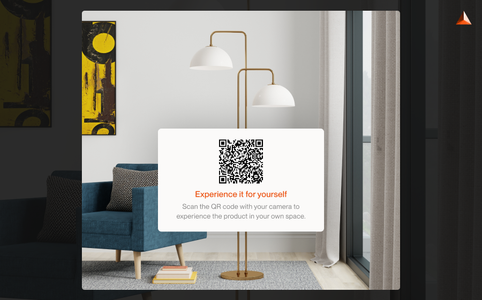Imagine this: a shopper searches for a chair on Google. Instead of scrolling through static photos, they spin the chair in 3D, zoom in on the fabric, and even place it in their living room using augmented reality — all directly from the search result.
No website visits. No downloads. Just immediate interaction.
That’s not a future scenario — it’s already happening. Google is now rolling out 3D and AR experiences in Search and Shopping Ads for certain product categories and markets. And it could fundamentally change how brands approach visual content.
Let’s break down what this new feature means, why it matters, and how you can make your products part of it.
Get the latest updates straight to your inbox.
By clicking sign up you'll receive occasional emails from imagine.io. You always have the choice to unsubscribe within every email you receive.
So, What is Google’s 3D Product Feature?
Google now supports 3D and AR product visuals on both free listings and paid Shopping ads. That means if you’re selling, say, a couch or a pair of sneakers, you can show them as fully rotatable 3D models — and on mobile, customers can even see them in their space using AR.
Here’s how it works:
- You provide Google with a lightweight 3D model of your product (in formats like .glb or .usdz)
- Google shows that model in relevant search results — no apps or loading screens needed
- Shoppers can engage directly, spinning, zooming, or placing the product in AR
Currently, this feature is limited to the U.S., Canada, Australia, Japan, and India, and is only available for certain categories like home goods and shoes. But make no mistake — this is just the beginning.
Why This Matters More Than You Think

If you work in ecommerce, marketing, product design, or anything customer-facing — this isn’t just a shiny add-on. It’s a shift in how people experience products online.
Here’s why it’s important:
-
Engagement Starts in Search
People already research and compare products on Google. Now, they can interact with your product before ever clicking through to your site. That gives early visibility a serious boost.
-
It’s Not Just Pretty — It’s Practical
3D lets customers see every angle. AR lets them see how it fits in their space. Both reduce friction and guesswork, which is great news for reducing returns and boosting purchase confidence.
-
It Outperforms 2D
Google’s internal data suggests that 3D and AR listings receive more customer interactions than standard images. That means higher-quality clicks and better-qualified traffic.
How Do Brands Get in on This?
To enable this feature, here’s what Google requires:
- A 3D model in .glb or .usdz format
- A publicly hosted link to that model added to your Merchant Center feed using the virtual_model_link attribute
- Optional: if you’re the product manufacturer, you can also use Manufacturer Center to prioritize your version of the model
Once you’ve added the model, it can show up in search results and Shopping Ads (if you’re running Performance Max or Standard Shopping campaigns) — often within two weeks.
This isn’t Just a Google Thing — It’s a Content Wake-Up Call

Whether or not your products are eligible for this feature today, it’s a clear sign of where online product content is headed:
More interactive. More immersive. More helpful.
Photos alone aren’t enough for modern shoppers, especially in categories like furniture, decor, apparel, and electronics. They want to explore. They want answers. And increasingly, they want it without leaving the search page. This puts pressure on brands to:
- Create lightweight, mobile-friendly 3D content
- Deliver that content across multiple touchpoints (not just their own site)
- Rethink visual storytelling from the lens of utility, not just aesthetics
How imagine.io Supports This
Okay, let’s keep it real: I work with imagine.io, and one of the things we’re known for is helping brands create scalable, interactive 3D content. That includes delivering GLB files — the same format Google uses for its 3D product previews in search.
But what’s more important than the format is the strategy. At imagine.io, we take a consultative approach to 3D. We support you through every stage — from creating high-quality, optimized 3D models to deliver them in any format you need, whether that’s GLB.
Our models are built to meet Khronos 3D Commerce standards, so they’re ready to be leveraged across ecommerce platforms, AR, digital ads, and now, search. We’re seeing more businesses ask:
- Can we create a 3D model once and use it across ecommerce, ads, AR, and now search?
- Can we cut down on time-to-market by replacing traditional photoshoots with 3D content?
- Can we future-proof our product visuals in a way that works everywhere?
The answer to all of that is yes — because 3D content is no longer just a nice-to-have. It’s becoming foundational to modern commerce.
Final Thoughts: Don’t Wait for Everyone Else to Do It First
Google’s 3D product rollout is still limited — for now. But just like mobile optimization or schema markup, it’ll soon become standard practice for serious ecommerce brands.
If you’re already investing in visual content, 3D should be part of that mix. Not only does it elevate how your products are perceived — it gets you in front of the right buyers, earlier in their journey, with more confidence.
And if your current visual workflows feel fragmented or slow, now’s the time to rethink how you create and scale product content.
Because let’s face it — the best place to show off your product may not be your product page anymore. It might be right there, in the search bar.


.gif?width=1296&height=1296&name=Untitled%20design%20(8).gif)




.png?width=500&name=How%20to%20Add%20a%203D%20Product%20Configurator%20to%20Your%20WordPress%20Website%20(Complete%20B2B%20Guide).png)
















%20(1).png?width=500&name=Why%20Exploded%20Mattress%20Views%20Matter%20(And%20How%20to%20Generate%20Them)%20(1).png)
.png?width=500&name=Best%20Shopify%20Product%20Configurator_%20How%20to%20Choose%20the%20Right%20One%20(2).png)
.png?width=500&name=Why%20Exploded%20Mattress%20Views%20Matter%20(And%20How%20to%20Generate%20Them).png)



.png?width=500&name=Best%20Shopify%20Product%20Configurator_%20How%20to%20Choose%20the%20Right%20One%20(1).png)







.png?width=500&name=How%203D%20Rendering%20Can%20Make%20or%20Break%20Your%20Industrial%20Design%20Pitch%20(1).png)








%20with%20Digital%20Twins%20and%203D%20Visualization.png?width=500&name=Optimizing%20Your%20Digital%20Asset%20Management%20(DAM)%20with%20Digital%20Twins%20and%203D%20Visualization.png)




.png?width=500&name=Styling%20Home%20Decor%20for%202025_%20From%20Global%20Influences%20to%20Playful%20Personalization%20(1).png)
